There’s nowt like fresh fruit and vegetables in their season its when they are at their very best, that also goes for meat, fish and game, you get something so wonderful when eating food as soon as it’s just been picked, it tastes better, it’s better for your wallet and it’s a healthier deal for the planet.
Food produced locally, whether you have bought from a farmers’ market, local butcher, greengrocer, or fishmonger; it is liable to be a lot fresher and tastier than its supermarket counterpart.
Meat produced with high regard for the animals concerned, without the addition of growth hormones, permanent fabricated daylight, and all the other sleight of hand tricks the producers use, then in your heart you know that the dairy, meat, and fish you purchase from high-quality local traders in its proper season will without doubt be of a far better-quality.
This is the start of our year even if it doesn’t feel like it, spring is almost here, in March, the weather starts to warm up (or so it should be doing), the time from now until about the middle of May is a tricky one for the shopper, grower, and greengrocer alike, winter vegetables are fading out whereas the spring veggies haven’t so far really got under way, however there is plenty of purple sprouting broccoli around so make use of it.
The beginning of the purple sprouting broccoli season brings and gives us a much sought after addition to the winter vegetable enjoyment.
Simply steamed or boiled, this vivacious cousin of broccoli can be used in the same way, it is leafier and deeper in colour than broccoli; it always adds vitality and crunch to vegetable dishes and it goes well with almost any fish or meat dish.
Broccoli is a cruciferous plant, from the same genus as the cabbage, and is associated to the cauliflower; cruciferous foods are nowadays hailed as having a number of significant health benefits. Purple Sprouting Broccoli contains the phytochemical sulphoraphane, which is thought to help prevent cancer. Furthermore it could provide resistance against heart disease, osteoporosis, and diabetes. It is packed with vitamin C and is a good source of caretenoids, iron, folic acid, calcium, fibre, and vitamin A.
Did I mention that it tastes great just simply steamed and served with melted butter and a squeeze of lemon juice?
As with the British asparagus season, the Jersey Royals season and the first of the British artichokes we always look forward to the first of the purple sprouting broccoli, in our opinion events like these are what makes British seasonal produce the finest in the world.
Fruit at It’s Best This Month
March sees the first of British rhubarb, and it is superb, but we are now seeing the last of our British apples and although we are still getting pears pretty soon they will be coming from further away. Citrus fruits are making their way from Spain and Sicily and there are of course lots of fruits around that do and have to come from far away, its just a matter of picking carefully where the fruit you choose does come from.
Best of British now is;
Apples, Forced Rhubarb, and Pears
Vegetables at Their Best This Month
In the spring month of March (yes it’s a spring month), Saint David’s day proclaims the month of March, and with St Patrick’s Day on the 17th, now is the time to think what we can be doing with all those tasty expected spring veggies, Lincolnshire starts to harvest carrots, beetroot, purple sprouting broccoli and calabrese broccoli as do other regions of Britain, so make the most from the first bloom.
We are seeing more and more spring vegetables in the markets and some supermarkets, so with excited expectation our thoughts are turning to lighter dishes as we see Chicory, Chives, Mint, Parsley, Radishes, Rosemary, Sorrel, Spring Greens, Thyme, and Watercress coming into their season, and Cornish Spring greens are also becoming more plentiful and are very tasty, jam packed full of flavour and sweetness, the two biggest enemies of cabbage are water and overcooking, the one thing you don’t want to do is boil it to death in a large saucepan of water. Simply remove any damaged outer leaves, cut it in quarters, removing the tough white ‘core’ in the middle, and slice it finely then you can either stir-fry it in a wok with oil, a little water and soy sauce or tip it into a saucepan with about 3 cm of boiling water and cook it fast for about 3 minutes, turning it over as you go. Drain it thoroughly, add a good chunk of butter, and season with salt and plenty of freshly ground white pepper. A small to medium size cabbage will easily serve 4.
Leeks are fantastic in early spring, and we like to use them, not only as vegetables to go together with poultry, meat and fish, but in soups, salads and tarts for first courses, we also like to lightly braise baby leeks as a lovely light side dish.
Don’t be afraid to buy them loose and covered with dirt the taste is much better than ones that have been washed and pre-packed.
Just cut off the top half of the green leaves and remove the root and any damaged outer leaves, cut vertically down the leek almost to the base and wash thoroughly between the leaves with cold running water slice the leeks thickly and wash again then cook in a little butter and oil.
They also make superb soups and we think they are very good in egg and cheese dishes.
Tasty tender spring carrots are about to show up, you can get a good sized carrot enough to make a salad for under 15p which makes it a brilliant student buy. Even organic ones which generally have much more flavour are affordable. Use them raw and freshly grated or just slice them, toss them in a pan with a little oil and melted butter, season them with salt, pepper and a pinch of ground cumin or coriander, add a couple of tablespoons of water, cover the pan with a lid or a piece of foil and let them cook very slowly in their own juices for about 20 minutes. They also make great soup and are a must for casseroles stews and stir-fries
New season artichokes from Italy, Cyprus, and Egypt are making their first appearance on the shelves, together with the first of the tomatoes with taste from Sicily and the black volcanic soil of Tenerife and Fuerteventura. Fast on their heels will be new potatoes from around the Mediterranean, asparagus (we had some superb asparagus from John Bussey’s Stall at the weekend) from the Murcia and Valencia provinces in Spain, and strawberries from Huelva in Andalucia.
So keep your eyes peeled for;
Beetroot, Brussels Sprouts, Carrots, Cauliflower, Celeriac, Celery, Chicory, Horseradish, Jerusalem Artichoke, Kale, Kohlrabi, Leeks, Onions, Parsnips, Potatoes (new), Purple Sprouting Broccoli, Radishes, Rhubarb, Rocket, Salsify, Shallots, Spinach, Spring Greens, Swede and Turnips.
Herbs and Nuts This March
There are lots of herbs available including growing pots of herbs alas not all from the UK but in the main they are all good and from quite close. I do have one gripe though we grow some wonderful parsley in the UK and English parsley is available now so could someone please tell me why the big supermarkets are selling parsley frown in Turkey?
At their best in March are;
Chives, Coriander, Cultivated Mushrooms, and Wild Mushrooms, Parsley (Curly), and Truffles (Black)
Meat, Poultry and Game at Its Best This Month
Beef, Chicken, Duck, and Pork are all very good and we are eagerly waiting for the first of British Spring Lamb, make the most of Rabbit this month wild rabbit meat, which is leaner and tastier than the farmed kind, has a wonderful delicate, gamey taste, very different from splendidly flavoured hare. Local Rabbit dishes reveal the fact that rabbit is very flexible and works well with those flavours used in chicken dishes, such as mustard and cream, tomato and herbs, and believe it or not chilli, I have had some superb rabbit dishes in Mexico.
Turkey, Venison, and Wood Pigeon are still good.
Fish and Seafood At Its Best This Month
Spring has sprung (sorry, couldn’t help that) and we are seeing a breath-taking range of seafood landed from around the Cornish coast, the one (and only) awful feature about the appearance of spring is that our beloved native mussels are off the seasonal menu until September we still have the rope grown imported mussels but they are not quite the same so, fill up on these juicy morsels while you can native oysters are now becoming more difficult to find and will soon be out of season however the pacific or rock oyster will always be a good substitute (just about) as they offer smaller portions with a more subtle taste.
Unusually the fishermen are still landing loads of mackerel and the season may go year round, large cod and Pollack are excellent at the moment we had some Pollack from Jon last week and it was fat, juicy, and sweet. We would also recommend the lemon sole, and what with the quite good Cornish lobster catches at the moment prices have been reduced, so now is the time to get lobster for that special meal.
With Mother’s Day approaching why not make your Mum, wife or girlfriend a really special seafood dish?
Mother’s Day is a great opportunity to say “thank you for everything”, and you can treat your Mum to some of the finest seafood in the world from the beautiful seas around this wonderful island of ours, our choice would be mussels at this moment in time they are fantastic
Cast Your Nets For;
Brill, Clams, Cockles, Cod, Conger Eel, Crab, Dabs, Dover Sole, Eel, Elvers, Haddock, Halibut, Hake, John Dory, Langoustine, Lemon Sole, Lobster, Mackerel, Monkfish, Plaice, Pollack, Scottish Wild Salmon is back in season, Sardines, Scallops, Sea Bream, Sea Trout, Skate, Squid, Turbot, Whitebait, and Winkles.
The Latest Grocery News
News courtesy of Supermarket Watch March 2012
Seasonal foods at their best in the supermarkets:
Vegetables: beetroot, broccoli, Brussels sprouts, cauliflower, carrots, cauliflower, celeriac, chicory, cucumber, jersey royal new potatoes, Jerusalem artichoke, kale, kohlrabi, leeks, onions, parsnips, potatoes (main crop), purple sprouting broccoli, rhubarb, rocket, salsify, shallots, spinach, spring onions and swede.
Herbs: chives, coriander, dill, mushrooms (cultivated), parsley (curly), sorrel and wild nettles.
Meat: beef, chicken, pork, rabbit, turkey, and wood pigeon.
Fish: cockles, crab, dab, dover sole, hake, john dory, lemon sole, lobster, mackerel, mussels, oysters, prawns, salmon, scallops, sea trout, shrimp, skate, whitebait and winkles.
Dates for Your Diary
27th to the 29th of April Cheese and Wine Festival, the Southbank Centre, London
LOCAL SHOPPING, PIMLICO, WESTMINSTER, VICTORIA
Tachbrook Street Market
 Address: Tachbrook Street, SW1
Address: Tachbrook Street, SW1
Trading hours: Monday to Saturday: 8am to 6pm
Nearest tube: Victoria or Pimlico, Bus: 2, 24, 36, 185, And 436
Open every day except Sunday, the number of stalls in this ancient street market increases as the week moves forwards, the market offers a wide array of goods from home furnishings and gardening equipment, to fruit and veg, fresh meat, fish, shellfish, bread and cakes.
Managed by Westminster Artisans Ltd on behalf of Westminster Council it is set to be a community hub thanks to its dynamic varied collection of stalls with scrumptious international hot food the paella is superb, fresh food, chocolate, cheese, olive oil, bread, funky fashion, and lots more.
Discover different stalls on different days it is an energetic market and we just love buying our fresh food at the market, fruit, vegetables, fish, and shellfish and this market is very close to us, and close enough to other shops such as; Tesco’s, Sainsbury’s, Rippon Cheese and some wonderful delis such as the Spanish Art Of Tapas, there are Italian delis, and Portuguese were we can pick up anything else for our cooking sessions.
It is also a superb lunch destination with loads of small specialist restaurants around and in the market itself something marvellous has happened it started last year when the market was refurbished and placed under the management of Westminster Artisans Ltd, Pimlico has welcomed the street food transformation and now you can by all the street food your heart desires from falafel to paella
Below you will see just what some of the stalls have to offer, we do hope to increase our list during the coming months and if you are a stallholder please email us with your details we welcome all the information we can get.
Capital Carboot Sale;
 Capital Carboot, Pimlico Academy, Chichester Street entrance, Lupus Street, London, SW1V 3AT
Capital Carboot, Pimlico Academy, Chichester Street entrance, Lupus Street, London, SW1V 3AT
Central London’s only indoor and outdoor all year round carboot sale, as seen in Timeout, Elle, I-D, Le Cool, and Emerald Street
Capital Carboot Sale runs every Sunday (except Easter, Christmas and New Year, please check availability during these times). Indoor stall holders should arrive at 9:30am if coming in a vehicle to unload. Unloading vehicles will not be allowed on site after 10:00am, outdoor stall holders without vehicles should arrive 10:15am, outdoor stall holders with vehicles to remain in the sale should arrive 10:45am. Early bird buyers entry is 10:15am (£5), Public entry is 11:30am until 3:30pm (£1).
You can find them at The Pimlico Academy, Lupus Street (Please use the Chichester Street entrance) Pimlico, SW1V 3AT.
The nearest tubes and trains are Pimlico (2 minutes walk) and Victoria (5 minutes walk), and on bus routes 360, C10, 24, 2, 36, 185, 436
You can book a stall at http://www.capitalcarboot.com/ or 0845 0943 871
Capital Carboot strongly advises buyers to use public transport when attending; parking is limited in the surrounding areas and a priority for local residents.
If you like to find good genuine bargains then you have to head to Pimlico for the best of car boot sales, Capital Carboot is attracting a young crowd, several selling vintage fashion and collectables so get there early to bag the best deals. This London based car boot sale is so much better than your average London car boot sale, it was set up last year by ex-stylist and personal shopper Faye Marriott and the happening is further encouraged with Twitter and Facebook, an element not often found with carboot events, this means that there is a much younger gathering of people but don’t worry there is still plenty for the more traditional car-booters and there has been sightings of celebrities searching for that special bargain.
Oh if you like the carboot on Facebook entry for buyers is free of charge.
You can now buy fresh fruit and veg here
Our Local Greengrocer,
John Bussey’s Stall on Tachbrook Street Market
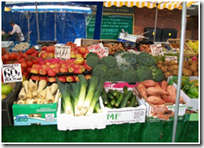 They only buy British produce on John Bussey’s stall when possible and in season, the family have had a stall on the market for 80 years now and they believe very strongly in supplying the best quality produce that is in season and at its best, they always seem to be the first to obtain the great British produce such as jersey royal potatoes, British asparagus, British soft fruits, when visiting look out for good sprouts, cauliflowers, leeks and cox’s apples; English berries and lettuce are available in season.
They only buy British produce on John Bussey’s stall when possible and in season, the family have had a stall on the market for 80 years now and they believe very strongly in supplying the best quality produce that is in season and at its best, they always seem to be the first to obtain the great British produce such as jersey royal potatoes, British asparagus, British soft fruits, when visiting look out for good sprouts, cauliflowers, leeks and cox’s apples; English berries and lettuce are available in season.
In fact they have all the fruit, veg and herbs you might want and so much better than the local supermarket’s offerings.
John’s stall was a picture it is wonderful to see such fresh produce full of energetic colours, especially the Rhubarb it really looked so vibrant and cooked up a treat when we made one of our favourite puddings, Maureen bought some blood oranges for me, they came from Sicily so not too far away and they were delicious, we also tried the asparagus and found it to be so full of flavour we could have sworn it was British, so what else was on offer?
Well there was Apples English Braeburns and Bramleys, Artichokes, Beets, English Broccoli, Butternut Squash, Cabbage, Cauliflower, Courgettes, English King Edward Potatoes, Fennel, Field Mushrooms, Leeks, Mache (Lambs Lettuce), Parsnips, Purple Sprouting Broccoli, Radish, Watercress, you can plainly see that all of what was available was in first-rate condition.
Vegetable/Fruit/Herb of the Week
Purple Sprouting Broccoli
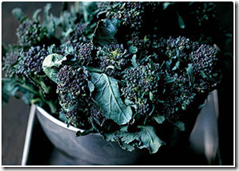 Available all year round. Best British Season Is; February, March, April
Available all year round. Best British Season Is; February, March, April
Following a somewhat skeletal couple of months on the leafy vegetable front, the commencement of the purple sprouting broccoli season heralds a much wanted addition to the winter vegetable enjoyment. Merely steamed or boiled, this lively cousin of broccoli can be used in the same way. It is leafier and deeper in colour than Calabrese; it always adds vitality and crunch to vegetable dishes and it goes well with almost any fish or meat dish. As with the British asparagus season, the Jersey Royals season and the first of the British Artichokes we always look forward to the first of the purple sprouting broccoli, in our opinion events like these are what makes British seasonal produce the finest in the world.
Purple sprouting broccoli was originally grown by the Romans; Broccoli has been grown in the United Kingdom since the 18th century, even though the purple sprouting type has only risen to celebrity in the last 20 years.
Broccoli is a cruciferous plant, from the same genus as the cabbage, and is associated to the cauliflower; cruciferous foods are nowadays hailed as having a number of significant health benefits. Purple Sprouting Broccoli contains the phytochemical sulphoraphane, which is thought to help prevent cancer. Furthermore it could provide resistance against heart disease, osteoporosis, and diabetes. It is packed with vitamin C and is a good source of caretenoids, iron, folic acid, calcium, fibre, and vitamin A.
Did I mention that it tastes great just simply steamed and served with melted butter and a squeeze of lemon juice?
Buying
Purple Sprouting Broccoli is outstandingly tasty when young and tender, look out for darkly coloured heads/spears with crunchy stalks, and no more than 1cm in diameter, which snap cleanly when broken always pass up easily bent broccoli.
Storing
In an airtight bag in the fridge.
Preparing and Cooking
Split thicker stalks about halfway up so that they cook at the same time as the heads/spears.
Steam, stir-fry or boil in a small amount of water, the tasty leaves are edible and so do not need to be removed.
We like it just boiled in salted water, drained, and served warm with melted butter and lemon juice.
Our Local Butcher, Freemans (Butchers) 117 Lupus Street
Trading Hours: Open: Mon to Sat 7.30am – 5.30pm Closed: Sun and Bank holidays
 John Freeman owner of Freemans butchers supplies high quality meat to the local residents of Pimlico and Westminster indeed people travel from all over London to purchase their meat from this traditional high street butcher.
John Freeman owner of Freemans butchers supplies high quality meat to the local residents of Pimlico and Westminster indeed people travel from all over London to purchase their meat from this traditional high street butcher.
He says that they are passionate about their product and are committed to ensuring quality meat at the best possible price; we aim for excellence with the right product, right price, and right quality 100% of the time he told me.
Their service level quality is kept up by constant staff development, and through customer feedback.
John constantly has superb meat and can get almost anything you want if given enough notice
Beef, lamb, and pork is good this month and our local butcher Freemans has some ox-tails and beef brisket in that is just so tasty his fore-rib of beef looked just about perfectly hung and at under £14 per kilo is probably the cheapest in London you really must give the classically trained butcher a go and just to see a real traditional butcher shop is a treat.
Butchers Choice
Rabbit
I just love the flavour and versatility of rabbit wild or farmed although wild rabbit meat is leaner and tastier than the farmed kind, has a wonderful delicate, gamey taste, so much different from a superbly flavoured hare.
leaner and tastier than the farmed kind, has a wonderful delicate, gamey taste, so much different from a superbly flavoured hare.
So often overlooked as a dinner option, which is a shame as I have said the meat is lean yet tasty especially wild rabbit, which has a superb tantalizing, gamey flavour, and this understated flavour gives itself to a range of cooking techniques.
Rabbit is available all year round in the UK Available all year round.
Best Season Is; July, September, October, November, December
Butchers are more likely to sell rabbit than supermarkets; try to avoid anything in excess of a kilo, as it can prove tough. The type of meat you can buy varies: ‘fryer’ is the leanest and tenderest; ‘roaster’, is a more mature rabbit, at its best when given a longer cooking time; last but not least there are the giblets, which are the organs of the animal. Take care when cooking rabbit, as the low fat content can make it dry if it’s not marinated beforehand, or basted during cooking.
Regional dishes from around the world show the fact that rabbit is very flexible and works well with those flavours used in chicken dishes, such as mustard and cream, tomato and herbs, and believe it or not chilli, I have had some superb rabbit dishes in Mexico.
Get hold of some rabbit and try one of the great classic recipes such as Braised Rabbit and Roast Rabbit with Rosemary or the recipe below although it isn’t one of mine it is a superb recipe and just the thing if this is your first time cooking rabbit.
Buying
Unlike a lot of Europe, rabbit is hardly ever seen in UK supermarkets although rabbit is back on the dinner table as sales of the game meat soar after being endorsed by celebrity chefs such as Nigella Lawson and Nigel Slater. And is becoming more commonly obtainable in butchers, supermarkets, try Waitrose for their excellent rabbit, and food markets.
It is also available by mail order from a number of suppliers, such as Woldsway Foods Ltd or the Wild Meat Company.
Select rabbits by size; they should be large enough to produce a sizeable amount of meat, wild rabbits larger than 1 kilo are liable to be tough, the younger, smaller rabbits will be more tender and suitable to faster cooking methods, for example roasting or barbecuing older rabbits will have more taste but can tougher so its better use these for braising, casseroling and in pies..
Storing
Fresh rabbit will keep in the fridge for several days (or longer if vacuum packed). I wouldn’t freeze rabbit as freezing can dry them out.
Preparing and cooking
To joint a rabbit, cut the hind quarters away from the body and separate the legs, halve the leg joints and cut the body (saddle) straight through the backbone into two or three portions, stopping at the rib cage, cut lengthways through the breastbone and divide the ribcage section in half.
As rabbit meat is very lean, care should be taken to prevent it from drying out during cooking, marinating or barding (covering in a fat or wrapping in bacon) can help moisten the flesh during roasting or barbecuing.
Casserole of Rabbit A Great heart-warming casserole with lovely taste of the forest
Serves: 4. Cooking-Time: 1hrs 0 minutes not one of my recipes but a recipe from Team MyDish on of course MyDish Recipe Sharing Made Easy
Our Local Fishmonger, Jon Norris on Tachbrook Street Market
Strolling through our local market on Tachbrook Street, SW1 you will probably see that  our favourite fishmonger Jonathan Norris has on display (and what a display) all you might ever want from your fishmonger for sale at a extremely affordable prices as well as other fish and shellfish that you don’t normally see on a market stall and furthermore you will see that the fish is caught from around the UK’s own shores with Scotland and Cornwall dominant.
our favourite fishmonger Jonathan Norris has on display (and what a display) all you might ever want from your fishmonger for sale at a extremely affordable prices as well as other fish and shellfish that you don’t normally see on a market stall and furthermore you will see that the fish is caught from around the UK’s own shores with Scotland and Cornwall dominant.
Jon is so friendly and a real character and when you speak to him you notice at once that he’s enthusiastic about all things fish, and when you ask him about the fish he has available you become aware that from his response that there’s nothing he and his staff don’t know about the produce they sell.
The fish is always in the best of condition, and as far as I can see always from sustainable sources. He explained to me after I asked him about it that “we take environmental issues very seriously and are continually striving to reduce the negative impact on our beautiful world wherever possible”. I got the feeling that he could even tell you what boat the catch came from.
Most all Jon’s fish is from around the Cornish, Devon, and Scottish coasts and we are still recommending the crab, mussels, whiting, and Pollack.
Jon put on show as usual with Cornish Brill, Clams including Razor Clams, Cod fillets, Cod steaks, Crab, Haddock, Cornish Hake, Halibut, John Dory, Lemon Sole, Megrim Sole, Dover Sole, Gilthead Bream, Cornish Gurnard, grey Mullet, Lobster, Scottish Mackerel, rope grown Mussels from the Shetland Isles, Monkfish, Cornish Octopus, there was Plaice from Scotland so plump and sweet, Prawns in the shell, there were Native Oysters, Rock Oysters, Scallops from the Isle of Man, wild Sea Bass, Skate, Sprats, Squid, Turbot, and Cornish Whiting.
Prices are so reasonable you have got to give this gifted and extraordinary fishmonger a try, you won’t be sorry, I promise.
Catch of the Day
Hake
 Catches of Northern hake, landed around the UK, are looking plentiful this season – so Seafish, the authority on seafood, is urging consumers to try this excellent whitefish.
Catches of Northern hake, landed around the UK, are looking plentiful this season – so Seafish, the authority on seafood, is urging consumers to try this excellent whitefish.
Hake, known as ‘Merluza’ in Spain, is a Spanish favourite and since the Spanish have the highest per capita consumption of seafood in Europe, they should know what they’re talking about.
Hake used to be a familiar fish to Britons but seems to have fallen from favour at a time when availability is very good. We only spent £1.5 million on chilled hake in supermarkets in the past year, compared to £124 million on chilled cod (Nielsen retail figures for 52 weeks leading up to 16 April 2011).
At its best from March to September, finer white flesh than cod and a much superior flavour, cook like cod.
Hake is an under-rated fish, which is a shame because it has a subtle and delicious flavour, similar to cod. Best of all, it is environmentally sustainable, yet inexpensive. It is also easy to prepare as it has relatively few bones.
The numerous fish that come under the designation ‘Hake’ are deep-sea members of the cod family and are popular throughout Europe especially Spain and Portugal also very popular in America. Hake is quite a mild flavoured fish, with a white flaky texture and a finer taste that is more subtle than that of its larger cousin the cod.
They are fished by bottom trawling with different mesh sizes for inshore and deep-water trawls. Ranging from 1kg to 5 kg and Hake has a soft, iron-grey skin and silvery belly. Also known as Cape Hake it is a sustainable fishery, as certified by the Marine Stewardship Council.
BUYING
Many varieties of hake are caught in waters around the world, particularly in the Atlantic and North Pacific. It’s available both fresh and frozen, and is sold either as a whole fish, or gutted with the head intact, or as fillets and steaks. Some varieties of hake have been greatly affected by over fishing. A lot of hake is now imported from South Africa.
Look for glistening pure white flesh that is free of signs of dryness, greyness, and browning. It should have a seawater fresh scent.
STORING
Refrigerate as soon as possible after purchase and use within a day, or freeze for up to three months.
PREPARING AND COOKING
Hake is a mildly flavoured fish. The flesh is quite soft, but firms up on cooking, and is worth trying. In France, hake is called ‘Saumon Blanc’ (which interprets as ‘white salmon’). Fillets require little preparation as the skin is soft, but checking for bones and pin-bones is necessary. It is popular in Spain and Portugal where it’s grilled, pan-fried, and baked. It takes robust flavours well, particularly tomatoes, garlic, chorizo, and paprika.
For a light, modern alternative to battered cod, try deep-frying hake fillets dipped in a light tempura batter.
Fishermen from the provinces on the Bay of Biscay, especially the Basques, introduced this fish into Spanish gastronomy, as for example, hake in potato casserole (Galician style). Coated with flour, it can be cooked in a pan with a little olive oil and served with a green sauce with some clams, or poached in cider with tomatoes and green onions.
Heating the fish fillets slowly in a cold pan prevents them from curling up during frying. This works really well for firm fish with thin skins, such as hake
In The Balcony Garden
Well we just might be able to get some salads, herbs, and some tomatoes in this year, they are making a start on our new windows at the beginning of April, and with a bit of luck ours should be done by May (hopefully).
Recipes for The Month
Casserole of Rabbit A Great heart-warming casserole with lovely taste of the forest
Serves: 4. Cooking-Time: 1hrs 0 minutes not one of my recipes but a recipe from Team MyDish on of course MyDish Recipe Sharing Made Easy
Pan-Fried Hake with Lemon and Parsley
 Fancy giving cod a rest and trying a different fish for a change?
Fancy giving cod a rest and trying a different fish for a change?
This is a very popular recipe in Spain its quick and easy and just right for a light lunch or supper.
Serves / Makes: 4 servings
Prep-Time: 10 minutes
Cook-Time: 12 minutes
YOU WILL NEED
2 tablespoons, seasoned plain flour
2 tablespoons, lemon zest, finely grated
10 grams, fresh flat leaf parsley, chopped
4 small fillets or steaks of hake about 80 to 90 grams each
2 tablespoons, olive oil
METHOD
Mix together the seasoned flour, lemon zest and parsley, pat onto the fish on both sides well, shaking off any excess.
Heat the oil in a large frying pan over a moderate heat; cook the fish for 11 to 12 minutes turning occasionally. Drain on kitchen paper and serve with lemon wedges and seasonal vegetables.
Serve and Enjoy!
Ribble Valley Mutton Pot Roast
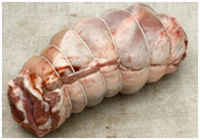 In the last few years, I have noticed what the chef’s are calling a return to the grass roots of British cuisine and seeing that a lot of mutton dishes abound I thought I would just add this one. I first came across it about 1969 when we had it on the menu at the Aspinall Arms at Mitton we only served it from about November until the spring lamb started coming in about March or April.
In the last few years, I have noticed what the chef’s are calling a return to the grass roots of British cuisine and seeing that a lot of mutton dishes abound I thought I would just add this one. I first came across it about 1969 when we had it on the menu at the Aspinall Arms at Mitton we only served it from about November until the spring lamb started coming in about March or April.
Serves/Makes: 6 to 8 servings
Prep-Time: 10 to 15 minutes plus 12 hours marinating time
Cook-Time: 2 hours
YOU WILL NEED
1 boned and rolled mutton shoulder
4 clove, garlic, crushed
2 fresh rosemary sprigs
5 teaspoons, fresh thyme leaves
2 teaspoons rowan or redcurrant jelly
1 glass of red wine
1-tablespoon olive oil
4 streaky bacon rashers, chopped
12 ounces, chopped onions
1 tablespoon, plain flour
1 cup, mutton stock, made from the bones from the shoulder
1-pound potatoes, a medium size, and cut into quarters
4 large carrots, halved crosswise
8 ounces wild or button mushrooms
Sea salt and freshly cracked black pepper to taste
METHOD
Combine the mutton, garlic, rosemary, thyme, rowan or redcurrant jelly, and wine to make the marinade. Place the mutton in the marinade and turn the mutton over and over to coat evenly. Cover and place in the fridge for at least 6 hours but better still overnight.
Heat the oven to 150c, 300f, gas mark 3.
Remove the mutton from the marinade and reserve the marinade, dry the mutton off with some kitchen paper. Then heat the oil in Dutch oven or heavy casserole over a medium heat add the mutton and cook until sealed, browned and well caramelised all over. Remove from the pan and add the bacon and onions and cook, stirring until golden, takes about 5 minutes. Stir in the flour and add the marinade and stock. Return the mutton to the pan and cover, put into the oven to cook for 45 minutes. Add the potatoes and carrots cover, and return to the oven and cook for 1 hour or until potatoes are tender.
Remove the mutton and vegetables to a warmed dish and cover with foil to keep warm. Bring the pan juices to a boil and boil until reduced and thickened slightly add Sea salt and freshly cracked black pepper to taste.
To serve carve the mutton into nice thick slices and surround with vegetables, pour over the sauce and serve. Serve and Enjoy!
NOTES
It’s sad that still we struggle for the most part in vain to find mutton in butcher’s shops and supermarkets; maybe we should start a campaign? What is the difference between mutton and lamb well mutton has a more intense, richer and has more depth of flavour than lamb and requires longer cooking times. It is extraordinarily well suited to roasting, stewing and braising although mutton can be available all year, the best meat is produced from October to March.
This is because the sheep have access to nutritious summer and autumn grass and heather, and are able to put on fat before being slaughtered.
Hebridean, Herdwick, Romney, Shetland, Southdown, and Welsh Mountain are just some breeds of sheep with an historical reputation for producing delicious mutton.
Chicken with Leek & Mushroom Sauce
One of my particular favourite meals the cognac, mushrooms, and leek add an elegant touch to the usual chicken breasts. And also at all times it went down a treat for the mid-week evening meals at Wilton Lodge and Norwood West, apart from for Lord H of course he couldn’t eat the leek although he liked the flavour I just used to serve it to him without the leek.
Serves / Makes: 4 servings
Prep-Time: 10 minutes
Cook-Time: 30 minutes
YOU WILL NEED
4 boneless, skinless chicken breasts (1 to 1¼ pounds total), trimmed
Salt & freshly ground white pepper to taste
1 tablespoon extra-virgin olive oil, divided
½ cup sliced leek, white only
1 tablespoon, chopped fresh thyme
Two cups, sliced mushrooms
¼ cup, Cognac
1-cup, chicken stock
2 teaspoons, plain flour
Lemon juice, to taste
1 tablespoon, chopped fresh parsley
METHOD
Season the chicken on both sides with salt and pepper.
Heat 1½ teaspoons oil in a large frying pan over a medium to high heat, add the chicken, and sear until well browned on both sides, about 3 minutes per side. Remove the chicken to a plate, cover, and keep warm.
Reduce the heat to medium, add the remaining 1½ teaspoons of oil to the pan, and then add the leek and thyme. Cook, stirring, for 2 minutes, and add the mushrooms cook for a further 5 minutes before adding the cognac let the cognac flame if you want to show off a little and then cook for about 2 minutes more. Transfer to a bowl, whisk the stock and flour in a small bowl, add to the pan and cook, whisking, until slightly thickened, about 3 minutes.
Return the mushroom mixture, chicken and any collected juices to the pan, reduce the heat to low and simmer until the chicken is cooked through, about 4 minutes.
Transfer the chicken to a warmed platter, season the sauce with salt, pepper and lemon juice to taste, spoon over the chicken garnish with parsley and Serve and Enjoy!
Hake with Peas and Asparagus
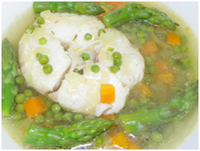 (Merluza con Guisantes y Esparrgos)
(Merluza con Guisantes y Esparrgos)
I remember having this dish many, many years ago at a friend’s house and then in 1972 in the little fishing villages of Cala Bona and Calla Millor (not so small now though) on the island of Mallorca we had it again and again. This recipe is as original as it gets, modern versions differ somewhat but we like this better especially in June when we serve it with steamed Jersey Royal Potatoes.
Serves / Makes: 4 servings
Prep-Time: 10 minutes
Cook-Time: 30 minutes
YOU WILL NEED
1 small onion
1 small carrot
1 sprig, parsley
2 tablespoons, olive oil
1 kilo, peas, frozen or fresh
1 kilo, hake, cut into portions
Salt and pepper to taste
300mls, fish stock, if we have no fish stock we like to use Knorr vegetable gel stockpots
12, cooked asparagus tips, we like to use the jumbo asparagus
METHOD
Chop the onion, carrot, and parsley and fry gently in a saucepan in oil, without browning. Add the peas and the hake, season, add the stock, and simmer for 30 minutes; put the asparagus tips in at the last moment, just to heat through.
Serve the hake surrounded by the peas, with the asparagus tips on top and Enjoy!
Jon’s tips to buying fish and shellfish
Fresh Whole Fish
The eyes should be clear and convex, not sunken
The flesh should be firm and resilient to finger pressure
The fish should smell freshly and lightly of the sea
Don’t buy fish with a strong ‘fishy’ or sulphurous odour, or that smells of ammonia.
Oily fish like herring, mackerel, and salmon should have a light, fresh oil smell, like linseed oil. If they smell of rancid oil, don’t buy.
Fresh Fillets
The surface of the fillet should be moist, with no signs of discolouration.
The texture should be firm, with no mushiness. Some separation of the muscle flakes (caused by the filleting process) is completely normal, but it shouldn’t be excessive.
As with whole fish, the smell should be fresh and light, with no ‘off’ odours.
Live bi-valves (including mussels, clams, and oysters)
The general rule of not buying bi-valves during any month spelled without an ‘r’ (i.e. May to August) still holds true, as this is the spawning season and quality will be poorer. When raw, the shells should be closed tight. Any slightly open shells that don’t close up in response to a few light taps should be discarded. When cooked, the shells should open – discard any that don’t.
Tagged: “Seasonal Recipes”, “What’s in Season”, Butchers, Cala Millor, Calla Bona, Catch of the Day, Chicken Recipes, easy, Fish, Fishmongers, food, Freemans, Fruiterers, Greengrocers, Hake, Hebridean, Herdwick, Jonathan Norris, Kimber Cottage, Lady Hanson, Lamb, Leeks, lemon, London, Lord Hanson, Mallorca, Markets, Mushrooms, Mutton, Norwood West, parsley, Pimlico, quick, recipe, Ribble Valley, Romney, Seasonal, Shetland, shops, Southdown, Spain, supermarkets, Tachbrook, Tachbrook Street Market, Welsh Mountain, Wilton Lodge




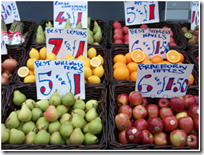
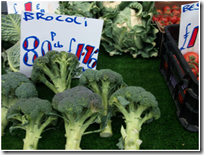

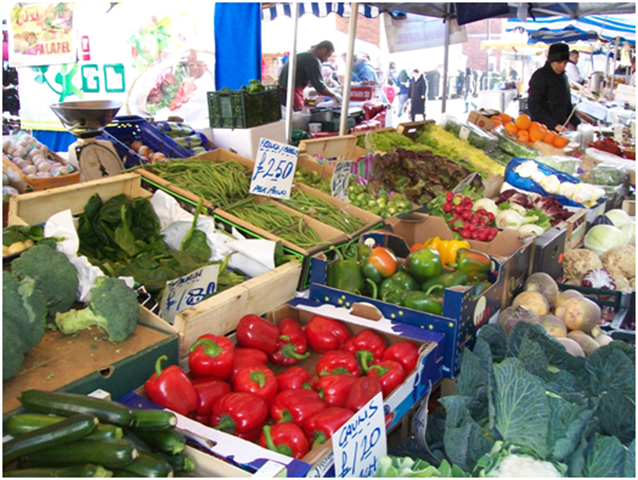
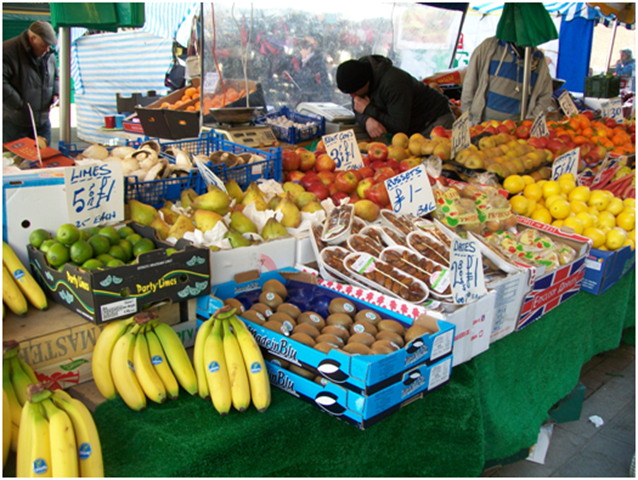
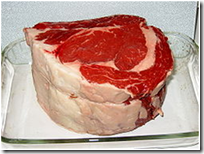
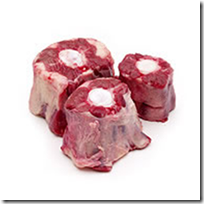

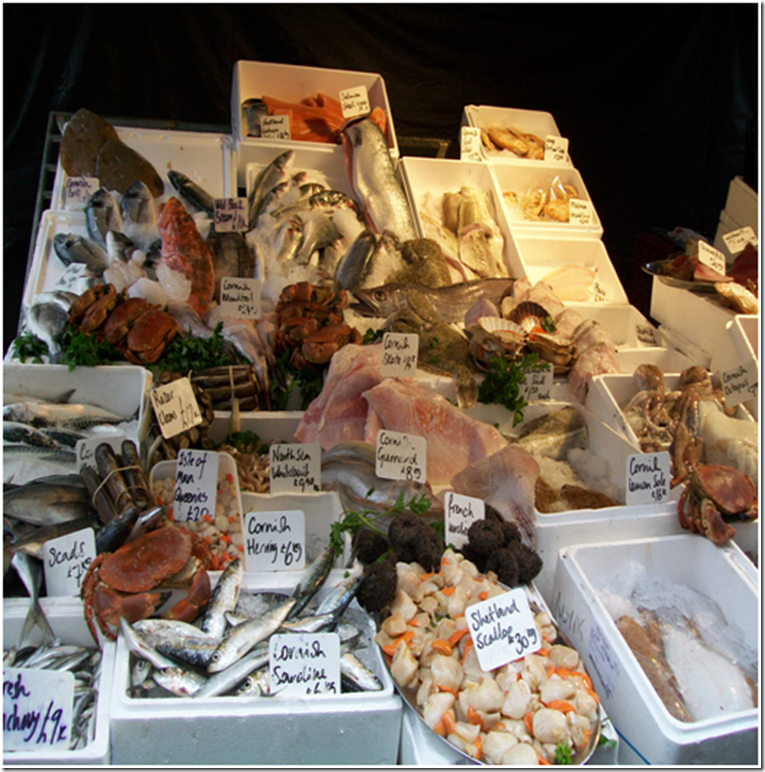
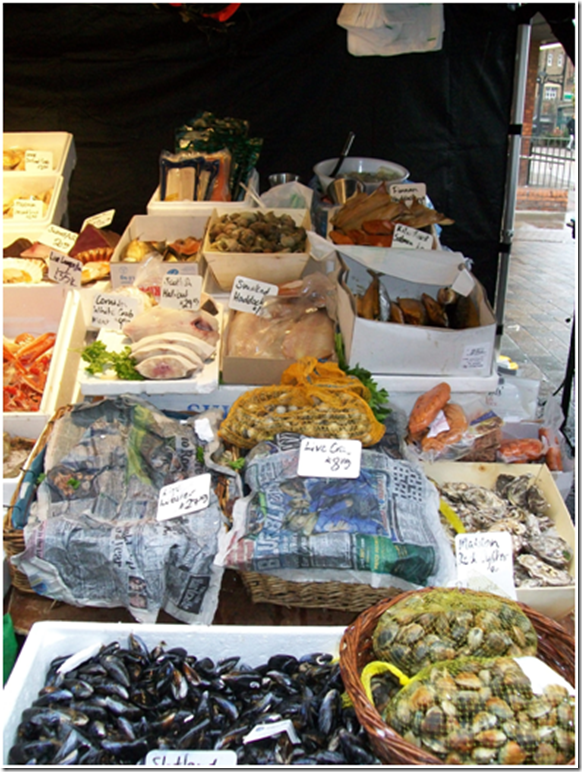



Thanks for the mention. Lovely, informative site. I’ll be back!
LikeLike